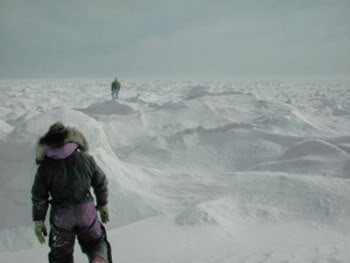Recent dramatic news points to both poles undergoing transformation due to climate change. This weekend an ice bridge disintegrated on the Wilkins Ice Shelf in Antarctica, leaving the whole shelf vulnerable to melting, and then yesterday new evidence was released of the impact of warming in the Arctic.
Younger thinner ice has become the dominant type in the Arctic over the past five years, reports a new study led by Research Associate Charles Fowler of the Colorado Center for Astrodynamics Research. The thinner ice does not bode well for the Arctic ecosystem, as the ice is more prone to summer melting.
 Data from NASA satellites show younger, thinner Arctic sea ice is replacing multi-year ice. Photo by: James Maslanik, University of Colorado. |
“Thickness is important, especially in the winter, because it is the best overall indicator of the health of the ice cover. As the ice cover in the Arctic grows thinner, it becomes more vulnerable to summer melt,” said researcher Walt Meier.
Historically Arctic ice has survived at least one summer without melting. Now, however, seasonal ice, which melts and re-freezes every year, has overtaken the Arctic landscape. Researchers have found that 70 percent of the ice in the Arctic is seasonal, as opposed to 40-50 percent in the 1980s and 90s. Ice that lasts two or more years only represents 10 percent of ice cover, a new low. Historically it has made up 30-40 percent.
“Heading into the 2009 summer melt season, the potential continues for extensive ice retreat due to the trend toward younger, thinner ice that has accelerated in recent years,” said James Maslanik, an aerospace engineering professor at the University of Colorado. “A key question will be whether this second year ice is thick enough to survive summer melt. If it does, this might start a trend toward recovery of the perennial sea ice pack. If it doesn’t, then this would be further evidence of the difficulty of re-establishing the ice conditions that were typical of 20 or 30 years ago.”
While total ice cover was up from previous years, it was still the fifth lowest maximum ice extent recorded. The lowest maximum this year was 5.85 million square miles. The past six years has seen all six of the lowest maximum ice extents.
Related articles
Black carbon linked to half of Arctic warming
(04/05/2009) Black carbon is responsible for 50 percent of the total temperature increases in the Arctic from 1890 to 2007 according to a study published in Nature Geoscience. Since 1890 the temperature in the Arctic has risen 1.9 degrees Celsius, linking black carbon to nearly an entire degree rise in Celsius or almost two degrees Fahrenheit.
Global warming to strengthen Arctic storms
(02/05/2009) Arctic storms could worsen due to climate change, putting fisheries, oil and gas exploration, and sea lanes at risk, warn researchers writing in the journal Climate Dynamics.
Arctic sea ice fell to the lowest volume on record in 2008
(12/17/2008) Arctic sea ice fell to the lowest volume and second lowest extent on record, according to the annual World Meteorological Organization (WMO) Statement on the Status of the Global Climate.
NOAA offers “dramatic evidence” of Arctic warming
(10/16/2008) Fall air temperatures 9degrees Fahrenheit (5 degrees Celsius) above normal, the second lowest-ever extent of summer sea ice, and the melting of surface ice in Greenland are signs of continued warming in the Arctic, according to the Arctic Report Card, an annual review of Arctic conditions by U.S. National Oceanic and Atmospheric Administration (NOAA) and its partners.
NASA: Sea ice melt opens the Northwest and Northeast Passage
(09/09/2008) An image released by NASA shows that Arctic sea ice has retreated to the point where both the Northwest Passage around North America and the Northern Sea Route around Russia are open simultaneously. The occurrence marks the first time on record that both passages have been open.
Sea ice loss may triple warming over northern Alaska, Canada, and Russia
(06/11/2008) Fast-declining Arctic sea-ice could spur rapid warming in northern Alaska, Canada, and Russia triggering thawing of permafrost and a release greenhouse gases from the frozen soils, reports a new study published in Geophysical Research Letters.
Sunshine worsens Arctic sea ice melt
(04/21/2008) Arctic sea ice is increasingly vulnerable to sunny days, concludes new research published in the journal Geophysical Research Letters.














